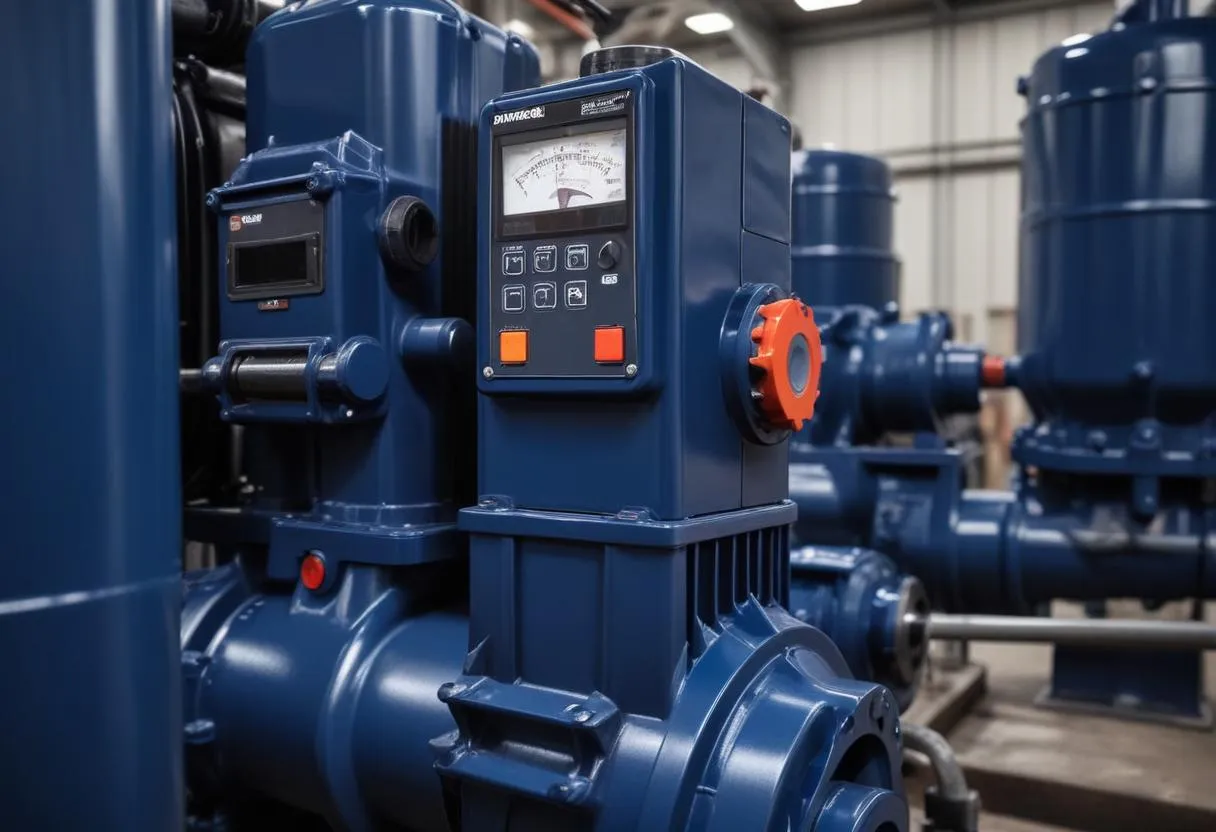 In the world of fluid mechanics and pump operations, understanding the pump performance curve is crucial. This curve indicates how a pump will operate under specific conditions, conveying the relationship between the head (pressure increase produced by the pump) and the flow rate (amount of liquid the pump is capable of moving).
In the world of fluid mechanics and pump operations, understanding the pump performance curve is crucial. This curve indicates how a pump will operate under specific conditions, conveying the relationship between the head (pressure increase produced by the pump) and the flow rate (amount of liquid the pump is capable of moving).
The performance curve is typically presented as a graph with the flow rate on the horizontal axis and the head on the vertical axis. This graphical representation helps operators and engineers determine the most effective operational settings for a pump in a given system. It clearly illustrates at what point the pump will run most efficiently and effectively.
Key components illustrated on a pump performance curve include:
- Flow rate (Q): Mostly measured in gallons per minute (GPM) or cubic meters per hour (m³/h), it represents the volume of fluid that a pump can handle.
- Head (H): Measured in meters or feet, this is the height to which the pump can raise the water.
- Efficiency curve: This line shows the percentage of efficiency at which the pump works at varying flow rates. This is crucial for determining the most economical point of pump operation.
- Power consumption: Indicated in kilowatts (kW), this represents how much power the pump consumes as it operates at different points along the curve.
- Net Positive Suction Head Required (NPSHR): This indicates the required pressure at the suction port of the pump to keep the liquid from vaporizing (cavitation).
The performance curve can vary significantly between different pumps, depending not just on their size and design, but also on the fluid they are designed to pump and the conditions of operation. For instance, pumps handling viscous fluids like oil will have different performance curves compared to those moving water.
To ensure clarity in understanding how changes in pump conditions affect performance, pump manufacturers often provide a series of curves, grouped together, known as composite curves. These might include:
| Curve Type | Description |
|---|---|
| Capacity | Shows various impeller sizes and their effect on flow rate. |
| Power | Displays how power consumption changes with changes in flow rate and head. |
| Efficiency Islands | Describes areas of maximum efficiency which guide operators in selecting the best pump speed and impeller size. |
By analyzing a pump performance curve, operators can make informed decisions about speed adjustments, impeller size, and even pump selection for a specific application. These adjustments are key in achieving a balance between energy efficiency, pump longevity, and operational effectiveness.
Introduction to system resistance curves
A system resistance curve, also known as a system head curve, is integral to understanding how a pumping system interacts with the fluid dynamics of the entire system. The curve portrays the relationship between the flow rate and the head loss in a system as the flow rate varies. Essentially, it graphs the total energy requirement needed to move the fluid through piping, fittings, valves, and other components as a function of flow rate.
When fluids are transported through a system, resistance occurs due to friction and other restrictive forces in the pipeline and components. The system curve is useful in visualizing this resistance. It typically rises quadratically, indicating that as the flow rate increases, the resistance, or head loss, increases at a squared rate.
Key elements featured in a system resistance curve include:
- Static head: The vertical distance that a pump must lift fluid, irrespective of the flow rate. This component of head does not change with the rate of fluid movement.
- Friction head loss: This accounts for the energy lost due to friction as fluid moves through the system’s conduits and components. It increases as the square of the flow rate increases.
- Velocity head: The energy required to accelerate the fluid to a certain velocity. This factor also rises with the square of the flow rate.
The total head required by the system at different flow rates is a sum of the static head, friction head loss, and velocity head. Depending on the complexity of the system, the curve can have different shapes, but it generally trends upward, steepening as the flow rate increases.
A simple table to explain the relationship between the flow rate and different types of heads in a hypothetical pumping system could look like this:
| Flow Rate (GPM) | Static Head (feet) | Friction Head Loss (feet) | Velocity Head (feet) | Total System Head (feet) | |
|---|---|---|---|---|---|
| 100 | 50 | 10 | 5 | 65 | |
| 200 | 50 | 40 | 20 | 110 | |
| 300 | 50 | 90 | 45 | 185 |
To derive a system resistance curve, one would plot these total head values against the flow rates. This curve is pivotal when it comes to selecting the right pump for a system because it defines the conditions under which the system will operate efficiently. Pump and system curve matching, which will be discussed in a subsequent section, uses these resistance curves to ensure that pumps operate at optimal conditions, minimizing wear and energy consumption while maximizing performance.
Techniques for optimal curve matching
 Achieving optimal pump and system curve matching is integral to ensuring that a pump system operates efficiently and effectively. This involves aligning the pump performance curve with the system resistance curve appropriately. Here are some techniques to guide the process:
Achieving optimal pump and system curve matching is integral to ensuring that a pump system operates efficiently and effectively. This involves aligning the pump performance curve with the system resistance curve appropriately. Here are some techniques to guide the process:
1. Identifying the Operating Point:
The first step in matching curves is determining the system’s desired operating point, which is where the pump curve and the system curve intersect. This point signifies the flow rate and head at which the pump will operate when installed in the system. It is crucial to ensure that this point lies within the pump’s efficient operational range.
2. Adjusting the Pump Speed:
One common method to achieve better matching is by adjusting the speed of the pump. Variable speed drives (VSDs) can be employed to fine-tune the pump speed, shifting the pump curve either up or down on the graph, thus changing the operating point until it achieves an optimal match with the system curve.
3. Modifying the Impeller Diameter:
Another effective technique involves modifying the impeller diameter. Trimming or increasing the impeller size can adjust the pump curve significantly. A trimmed impeller reduces the flow rate and head, which might better align the pump performance curve with a lower system resistance curve.
4. System Modifications:
Sometimes, altering the system configuration is more feasible than adjusting the pump. This can include changing the pipe diameter, modifying the layout, or replacing valves and fittings to alter the system resistance curve. Adjusting these elements can reduce or increase the system’s resistance to better match the pump’s operational curve.
5. Use of Control Valves:
Adding control valves in the system allows for dynamic adjustments of the flow rate and head to match the pump’s performance curve more closely with the system curve during varying operational conditions. This, however, must be done carefully, as throttling can increase energy consumption and reduce system efficiency.
Simulation and Modeling:
Advanced techniques involve using software tools for simulation and modeling. These tools can predict how changes in pump speed, impeller size, or system configurations will affect the interaction between the pump and system curves. This can be a powerful way to foresee and optimize operations before making physical adjustments.
7. Multiple Pumps in Parallel or Series:
In larger systems, operating multiple pumps in parallel or series can provide flexibility and better matching of the curves. Pumps in parallel can increase the flow rate without affecting the head much, while pumps in series can increase the head without significantly changing the flow rate. Choosing the right configuration depends heavily on the specific needs and layout of the pumping system.
Review and Adjustment:
Lastly, continuous monitoring and review of the pump operation and system performance are necessary. Over time, wear and tear on the pump and changes in the system can shift the operating point. Regular reviews help ensure that the pump remains well-matched with the system curve, maintaining efficiency and effectiveness.
In summary, optimal matching of pump and system curves is not a one-time adjustment but an ongoing process. It requires a thorough understanding of both the pump’s capabilities and the system’s demands, along with a thoughtful application of adjustments and technologies to achieve and maintain efficient operation.